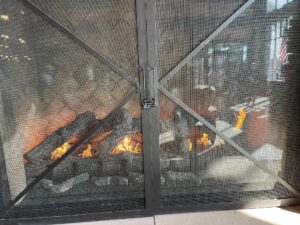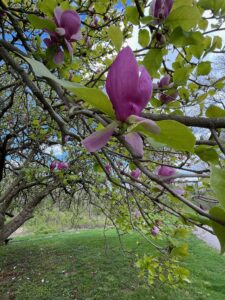A temporary ban on campfires on Pennsylvania State Game Lands is in effect
By Steven Brodsky
The following news release was issued by the Pennsylvania Game Commission on November 5, 2024:
CAMPFIRES TEMPORARILY PROHIBITED ON STATE GAME LANDS
With much of Pennsylvania abnormally dry, and wildfires impacting many areas, the Pennsylvania Game Commission is temporarily prohibiting the building of fires on state game lands.
While camping on state game lands is prohibited, regulations allow game lands users to build small fires for cooking or warming purposes. However, the regulation authorizes the Game Commission’s executive director to restrict otherwise-permitted activity when the threat of forest fire exists.
The prohibition on building fires on game lands will be left in place indefinitely until conditions improve.
“Taking this one, small step now to address wildfire risk could prevent a larger problem as we get deeper into the heart of hunting season,” Game Commission Executive Director Steve Smith said. “Doing what we can to protect wildlife habitat in what might be a hunter’s favorite spot benefits both, and might make all the difference.”
The Game Commission is among a number of state agencies to enact measures addressing dry conditions. The state Department of Conservation and Natural Resources (DCNR) today issued a similar ban on campfires in state parks and state forests, as well as suspension of any prescribed burns on DCNR lands. The Game Commission conducts prescribed burns to improve wildlife habitat on select state game lands, mainly in the spring and early fall, and is temporarily suspending prescribed burns on game lands, as well.
“While the Game Commission recognizes the value of prescribed fires under the right conditions, that time is clearly not now,” said Scott Bearer, Game Commission Chief Land Manager.
The Pennsylvania Drought Task Force has declared drought conditions in 35 of the state’s 67 counties. The state has experienced 100 reported wildfires in the past week, with many more unreported. Several volunteer firefighters were injured in blazes this weekend and these ongoing wildfires have strained state and local resources. Nearly 50 Game Commission personnel trained in fire management have been actively involved in suppression activities and structure protection, in partnership with DCNR and the Pennsylvania Emergency Management Agency.
Posted 11-7-24
The annual cold weather life jacket requirement period in Pennsylvania has begun
By Steven Brodsky
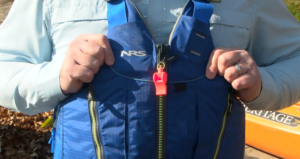
Photo courtesy of the Pennsylvania Fish and Boat Commission (PFBC)
The following press release was issued by the Pennsylvania Fish and Boat Commission (PFBC):
HARRISBURG, Pa. (October 31) – The Pennsylvania Fish and Boat Commission (PFBC) reminds boaters, anglers, and hunters that beginning tomorrow, the annual cold weather life jacket requirement is in effect.
From November 1 through April 30, boaters are required to wear a U.S. Coast Guard approved life jacket while underway or at anchor on boats less than 16 feet in length or on any kayak, canoe, or paddleboard. The requirement applies to all Pennsylvania waters.
 “Outdoor opportunities are still plentiful during the fall and winter seasons, and many people are still enjoying the water, whether paddling, fishing, waterfowl hunting, or taking a scenic foliage tour,” said Adam Spangler, PFBC Boating Safety Specialist. “Boaters should be aware that water temperatures begin to drop rapidly at this time of year, and even on sunny days when air temperatures are comfortable and warm, the water is already cold enough to cause cold water shock, hypothermia, and put your life at risk. A life jacket can keep your head above water until help arrives.”
“Outdoor opportunities are still plentiful during the fall and winter seasons, and many people are still enjoying the water, whether paddling, fishing, waterfowl hunting, or taking a scenic foliage tour,” said Adam Spangler, PFBC Boating Safety Specialist. “Boaters should be aware that water temperatures begin to drop rapidly at this time of year, and even on sunny days when air temperatures are comfortable and warm, the water is already cold enough to cause cold water shock, hypothermia, and put your life at risk. A life jacket can keep your head above water until help arrives.”
Sudden cold-water immersion, or cold-water shock, occurs when a person is unexpectedly plunged into cold water resulting in an involuntary gasp where water is often inhaled. This uncontrollable reaction causes panic, hyperventilation, inhalation of water, and inhibits the ability of a person to swim.
According to Pennsylvania boating accident reports, nearly 80% of all boating fatalities occurred because boaters were not wearing life jackets. Since the mandatory life jacket wear law was enacted in 2012, the PFBC has seen a significant drop (approximately 50%) in the percentage of boating incidents resulting in fatalities during the cold weather months.
The PFBC also recommends that anglers participating in ice fishing this winter always wear a life jacket to provide lifesaving protection in the event of a fall through the ice.
Individuals who plan to boat or participate in ice fishing during the cold weather months should follow these Cold Water Survival Safety Tips:
-
Always wear a life jacket, even when not required.
-
Never boat alone.
-
Leave a float plan with family or friends to indicate where your boating trip will begin and end, and when you expect to return.
-
Become familiar with the waters you plan to boat in advance of your trip.
-
Bring a fully charged cell phone with you and store it in a waterproof container.
-
Wear clothing that insulates when wet, such as fleece, polypropylene, or other synthetics
-
If you are about to fall into cold water, cover your mouth and nose with your hands to prevent inhaling water.
-
If your boat capsizes, stay with the boat, and if possible and get back into or climb on top of the boat.
-
While in cold water, do not remove your clothing.
-
If you cannot get out of the water and you are wearing a lifejacket, get into the Heat Escape Lessening Posture (HELP), bringing your knees to your chest and holding them close to the body.
-
Once out of the water, remove wet clothes and warm up as soon as possible.
-
If you have been exposed to cold water, act on the side of caution, and seek medical attention when necessary.
To learn more about boating basics, regulations, and how to take a boating safety course, visit the Boating page on the PFBC website (Fishandboat.com).
The Wear It Pennsylvania campaign and logo are a partnership between the PFBC and the National Safe Boating Council.
Posted 11-2-24
Pennsylvania motorists can reduce their chances of collisions with deer by being ‘extra mindful’ of increased deer activity occurring this time of the year and by understanding deer behavior
By Steven Brodsky
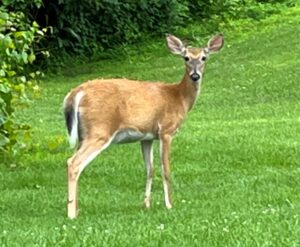
Photo by Steven Brodsky
From a news release that was issued by the Pennsylvania Game Commission (PGC) on October 22, 2024:
With deer becoming increasingly active, and daylight-saving time soon to put more vehicles on the road during the hours when deer move most, the Pennsylvania Game Commission is advising motorists to slow down and stay alert.
Deer become more active in autumn with the lead-up to their fall breeding season, commonly referred to as the “rut.” Around this time, many yearling bucks disperse from the areas in which they were born and travel, sometimes several dozen miles, to find new ranges. Meanwhile, adult bucks more often are cruising their home ranges in search of does, and they sometimes chase the does they encounter.
When daylight-saving time ends Nov. 3, there also will be increased vehicular traffic between dusk and dawn – the peak hours for deer activity.
“As the rut approaches, whitetails are ramping up their activity levels and expanding their home ranges,” said Game Commission Executive Director Steve Smith. “We would like to encourage all drivers to be extra mindful of intensified deer movement this time of year.”
Data from around the country indicates Pennsylvania drivers face some of the highest risks of a vehicle collision with a deer or other large animal. A recent report shows Pennsylvania led the country in animal-collision insurance claims in the fiscal year 2023-24. Meanwhile, Pennsylvania drivers, according to the report, have a 1-in-61 chance of a vehicular accident involving a big game animal – one of the highest rates nationwide.
Drivers can reduce their chances of collisions with deer by staying alert and better understanding deer behavior. Just paying close attention while driving on stretches marked with “Deer Crossing” signs can make a difference.
Deer often travel in groups and walk single file. So even if one deer successfully crosses the road in front of a driver, it doesn’t mean the threat is over. Another could be right behind it.
Posted 10-24-24
The Pennsylvania Game Commission asks the public to report Pennsylvania sightings of ‘two or more dead hares or rabbits at the same location with an unknown cause of death’
By Steven Brodsky
From a Pennsylvania Game Commission news release issued on October 18, 2024:
Report mortality events
RHDV2 is a highly contagious virus posing a serious threat to the state’s rabbits and hares because it can cause mass die-offs – 75-100% of local populations – when and where it becomes established. There is no specific treatment for RHDV2 and it can remain on the landscape for months.
Early detection of RHDV2’s possible presence, and the immediate removal of suspect carcasses, is the best way stop its spread.
The Game Commission is asking hunters – and anyone else, really – who finds two or more dead hares or rabbits at the same location with an unknown cause of death to report that by calling 1-833-PGC-WILD or by using the Game Commission’s online Wildlife Health Survey reporting tool at https://www.pgcapps.pa.gov/WHS.
Domestic hare and rabbit owners with questions about this disease should contact their veterinarians, who can in turn report suspect animals to the Pennsylvania Department of Agriculture’s Bureau of Animal Health at 717-772-2852, option 1. Calls can be made anytime 24/7.
RHDV2 poses no human health risk. Multiple sick or dead hares in one place also can be an indication of tularemia or plague, though, and those diseases can cause serious illness in humans. So the public should not handle or consume wildlife that appears sick or has died from an unknown cause. Keep pets away from such specimens, too.
The virus has only been detected in Pennsylvania once before, in a domestic facility in Uniontown, Fayette County. It has never been found in wild populations.
Posted 10-20-24
The Pennsylvania Department of Transportation (PennDOT) is offering a new PA Sportsman license plate; this specialty plate will benefit youth hunting and fishing programs
By Steven Brodsky
… The new PA Sportsman license plate was unveiled yesterday, September 30, 2024.
Video of the license plate unveiling ceremony:
From a news release issued by the Pennsylvania Game Commission (PGC) and the Pennsylvania Fish and Boat Commission (PFBC):
HARRISBURG, Pa. (September 30) — Just in time for the fall hunting and fishing seasons, the Pennsylvania Game Commission (PGC) and Pennsylvania Fish and Boat Commission (PFBC) are excited to announce the offering of the new PA Sportsman license plate!
The specialty plate, available now through the Pennsylvania Department of Transportation (PennDOT), is adorned with artwork featuring iconic Pennsylvania hunting, fishing, and boating imagery including the white-tailed deer, ruffed grouse, and anglers fishing from a kayak on a scenic river. The license plate costs $40 plus the registration fee, of which $14 will be deposited into a Youth Hunting and Fishing Restricted Account to be allocated evenly to the PGC and PFBC for the purpose of promoting youth hunting and fishing activities.
“The outdoors are important to so many Pennsylvanians, and our state’s outdoor resources – both now and in the future – depend upon the people who care enough to protect them,” said PGC Executive Director Steve Smith. “Hunters, trappers, boaters and anglers play an active role in conserving fish and wildlife and their habitats, but the torch they carry ultimately will be passed to the generations to come, highlighting the continual need to involve youth in these activities and shape them as stewards who one day can pass the torch to those who follow. With this license plate, sportsmen and sportswomen can help that cause while showing their pride in the things that make it all possible.”
PFBC Executive Director Tim Schaeffer reinforced the value of growing youth education programs around conservation-based recreational activities and stressed the importance of safety for those who enjoy the woods and the water.
“Fishing and boating are year-round lifetime activities for individuals and families in Pennsylvania,” said Schaeffer. “It’s critical that we introduce young people to outdoor recreation and instill a conservation ethic early on. Equipped with the skills needed to enjoy all that Pennsylvania’s waters have to offer, they are also more likely to become stewards of our aquatic resources. To me, the best part of the license plate may be that the adult and child depicted are wearing their life jackets. It will be great to have that public safety reminder on roadways across the Commonwealth.”
Both the PGC and PFBC have youth education programs that encourage interest in outdoor recreational activities including hunting, trapping, fishing, boating, and conservation.
Popular PFBC youth programs include Trout in the Classroom (TIC), which provides educational experiences for students and teachers who raise Rainbow Trout from eggs to fingerling-size fish in aquariums as part of their school curriculums. During the 2023-24-25 school year, 57,114 students in 417 classrooms across 61 counties participated in TIC. Additionally, each year on the Saturday before the statewide opening day of trout season in April, the PFBC holds its Mentored Youth Trout Fishing Day. This special day is offered annually to allow youth participants ages 15 and under to learn how to become successful, ethical anglers while fishing with their licensed adult mentors.
The PGC reaches into more than 300 schools statewide through its administration of the National Archery in the Schools Program and offers educational curricula through its Wildlife on WiFi and Seedlings for Schools programs. Junior Game Warden Camps held each summer provide an opportunity for youth to experience the broad scope of work performed by conservation officers, while organized Junior Pheasant Hunts might give young hunters their first glimpse of the action that awaits them afield.
These programs are just a snapshot of each agency’s involvement with youth.
The Pennsylvania Department of Transportation (PennDOT) offers several special fund registration plates, including the PA Sportsman plate. These plates support various causes across the Commonwealth from preserving Pennsylvania’s heritage to honoring veterans.
“Our goal was to help create a design that resonates with everyone who enjoys the outdoors while serving as a reminder of Pennsylvania’s abundant wildlife,” said PennDOT Secretary Mike Carroll. “When you display this plate, it tells other Pennsylvanians and people throughout the country that you’re a dedicated hunter, an enthusiastic fisherman, or someone who supports the state’s natural resources.”
The PA Sportsman license plate was created through Act 51 of 2024 which was signed into law by Gov. Josh Shapiro on July 8, 2024. The legislation, sponsored by Senator Wayne Langerholc, Jr. (PA-35), designates the funds generated by sales of the plates to youth hunting and fishing programs in Pennsylvania.
“This license plate allows our rich heritage of hunting and fishing to be proudly displayed by motorists while raising money for future generations of hunters and fishermen,” said Langerholc. “I look forward to seeing these beautiful license plates displayed on vehicles as I travel throughout my district and beyond, knowing that we’re keeping kids involved in the outdoors.”
Members of the Pennsylvania Governor’s Youth Council for Hunting, Fishing and Conservation (Youth Council) joined in celebrating the offering of the PA Sportsman license plate, noting the need for additional funding for programs that engage their young peers in outdoor recreational opportunities.
“Empowering youth through access and opportunity to outdoor recreation like hunting and fishing not only builds a deeper connection to our natural resources but also builds Pennsylvania’s next generation of conservation leaders,” said Grace Ziegmont, Youth Council President. “Programs supported by this license plate will reach a wide diversity of Pennsylvania’s youth and help empower them to protect and steward our fish and wildlife resource for generations yet to come.”
To purchase a PA Sportsman specialty license plate, visit the PennDOT website, choose Special Fund, and select the PA Sportsman option.
For more information on youth hunting, fishing, and boating education programs, visit the PGC and PFBC websites.
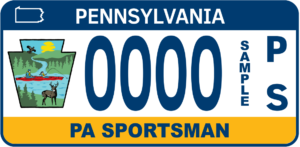
Image courtesy of the Pennsylvania Department of Transportation (PennDOT)
Posted 10-1-24
Nearly 500 cyclists participated in the Brandywine Conservancy’s sixth annual ‘Bike the Brandywine’ event; proceeds from the event will benefit the Brandywine Conservancy’s open space and clean water programs
By Steven Brodsky
… Kudos to the Brandywine Conservancy, the sponsors and, of course, the cyclists for the successful and enjoyable event!
From the Brandywine Conservancy:
Chadds Ford, PA, September 23, 2024 — The Brandywine Conservancy’s “Bike the Brandywine” event returned for its sixth edition on Saturday, September 21 with nearly 500 cyclists enjoying a partly cloudy day along the Brandywine Creek Greenway and surrounding Chester County countryside. This year’s event featured three scenic loops filled with stunning views of the area’s rural landscapes, rich history and active farmland—much of which the Brandywine Conservancy has helped permanently protect and conserve over the past 55 plus years. Proceeds from the ride benefited the Brandywine’s open space and clean water programs.
Participating cyclists chose from distances of 25, 45 and 62 (Metric Century) miles, with each loop beginning and ending at the Chadds Ford Historical Society. The Metric Century and 45-mile routes took cyclists through the rolling hills of Unionville, PA, with scenes of bucolic countryside and historic sites, before winding through Modena and the village of Marshallton. Cyclists on the 25-mile route followed along the West Branch of the Brandywine through open farmland, scenic river alleys and equestrian landscapes.
Upon returning to Chadds Ford, cyclists were welcomed back with celebratory drinks from 2SP Brewing Company and a complimentary lunch provided by the Brandywine Museum of Art’s Millstone Café staff. Bike the Brandywine was generously supported by presenting sponsor, Willowdale Town Center, along with supporting sponsors Anemoni Jewelers, Holly Gross Group of Berkshire Hathaway Home Services, Trek Bicycle Delaware, 2SP Brewing Company and Chadds Ford Historical Society.
About the Brandywine Creek Greenway:
The Brandywine Creek Greenway is a regional planning initiative of the Brandywine Conservancy—involving 29 municipal partners in Chester and Delaware counties in Pennsylvania and New Castle County and the City of Wilmington in Delaware—to create a 40-mile-long conservation and recreation corridor along both branches of the Brandywine. The Greenway stretches from the Christina River in the City of Wilmington, Delaware, to the Pennsylvania Highlands in Honey Brook Township. The Brandywine Creek Greenway and its network of parks and trails form the western limit of the Circuit Trails, a regional trail network of the greater Philadelphia region. The vision of the Brandywine Creek Greenway is to build healthier, more sustainable communities, by emphasizing the natural and cultural resources of the area; preserving and protecting the Brandywine River; and creating connections among open space, parks, river access points and area attractions. To learn more, visit www.brandywinegreenway.org
About the Brandywine Conservancy:
The Brandywine Conservancy protects water, conserves land, and engages communities. The Conservancy uses a multi-faceted approach to conservation. Staff work with private landowners who wish to see their lands protected forever and provide innovative community planning services to municipalities and other governmental agencies. The Conservancy currently holds more than 510 conservation and agricultural easements and has facilitated the permanent preservation of over 70,200 acres of land. The Conservancy is a program of the Brandywine Conservancy & Museum of Art.
About the Brandywine Conservancy & Museum of Art:
The Brandywine Conservancy & Museum of Art preserves and promotes the natural and cultural connections between the area’s beautiful landscape, historic sites, and important artists. The Conservancy protects the lands and waters throughout the Brandywine Valley and other priority conservation areas, developing sustainable approaches to emerging needs and assuring preservation of majestic open spaces and protection of natural resources for generations to come. The Museum of Art presents and collects historic and contemporary works of American art, engaging and exciting visitors of all ages through an array of exhibitions and programs. The Brandywine unites the inspiring experiences of art and nature, enhancing the quality of life in its community and among its diverse audiences.
Posted 9-23-24
In a proper season
By Steven Brodsky
… appeared this frog (and the shadow it cast upon a lotus leaf):
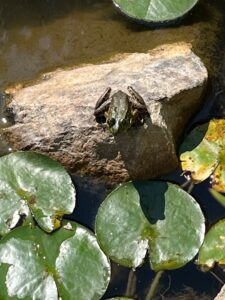
Photo by Steven Brodsky
Ecclesiastes 3 KJV (biblehub.com)
This post appeared in the Conversations About Faith section of this column.
Posted 4-25-24, Reposted and Revised 8-14-24
Exquisite is the monarch butterfly chrysalis stage
By Steven Brodsky
… as pictured here:
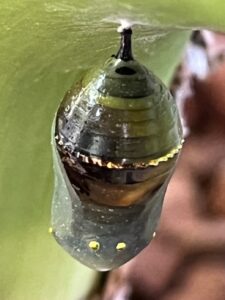
Photo by Steven Brodsky
I can’t say that I find the adult stage of the monarch butterfly to be more exquisite than the monarch chrysalis stage.
Which stage is more exquisite?
Not an easy question (for me) to answer.
It’s easier to simply enjoy seeing these two life stages of the monarch butterfly in the great outdoors!
Posted 8-7-24
Coming into the peace of some wild things
By Steven Brodsky
… with this photo and “The Peace of Wild Things”:
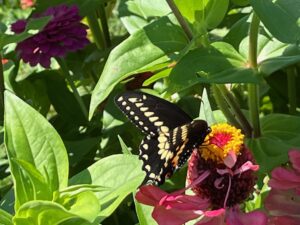
Photo by Steven Brodsky
Posted 7-9-24
A creature comfort
By Steven Brodsky
… The top of a shrub served as a sort of hammock for this garter snake:

Photo by Steven Brodsky
The snake paid rent (so to speak) via its consumption of slugs.
A gardener who was alarmed by the snake didn’t consider that to be sufficient compensation.
The snake was not harmed.
Posted 5-1-24
‘Nature rarer uses yellow’
By Steven Brodsky
… wrote Emily Dickinson: https://www.online-literature.com/dickinson/poems-series-2/106/.
Thought of the poem today when this early spring spattering of translucent yellow came into view trailside in a National Park:
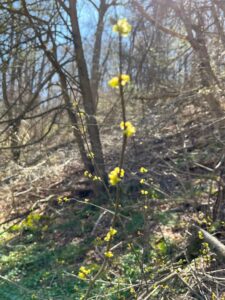
Photo by Steven Brodsky
Some of this column’s readers will recall the Emily Dickinson poem the next time that they take notice of nature’s yellow in the great outdoors.
Posted 3-24-24
A tarantula species was named after Johnny Cash 8 years ago, on February 5, 2016
By Steven Brodsky
… The species is found near Folsom State Prison, the venue where Johnny Cash’s first live album, Johnny Cash at Folsom Prison, was recorded on January 13, 1968. The album was released on May 6, 1968.
Folsom State Prison is located in Folsom, California.
The tarantula species is named Aphonopelma johnnycashi: http://www.sci-news.com/biology/aphonopelma-johnnycashi-new-tarantula-species-johnny-cash-03615.html.
Posted 2-5-24
Most people can relate
By Steven Brodsky
… to the kind of death that was experienced by the character in Seamus Heaney’s poem “Death of a Naturalist.”
Posted 7-12-22
A Conversation With Katie Fallon, Author of ‘Vulture: The Private Life of an Unloved Bird’
By Steven Brodsky
Katie Fallon is a co-founder of the Avian Conservation Center of Appalachia. She’s worked with many species of raptors and other kinds of birds. Katie’s books include Cerulean Blues (2011) and the recently released Vulture: The Private Life of an Unloved Bird. Her essays have appeared in a number of literary journals. She has a lifelong love of nature. I’ve heard that the first word she ever spoke was “bird.”
Your new book gives vultures, particularly turkey vultures, the positive attention these non-predator raptors deserve. What brought about your interest in these maligned birds?
I’ve been fascinated by vultures for at least fifteen years. There was a roost near where I lived in West Virginia; every day I’d drive by this big, old dead tree with ten or so turkey vultures hunched in it. They became a familiar sight, and I looked forward to seeing them. Vultures are big and kind of dramatic, and in flight, there’s nothing more beautiful. In addition, they’re the ultimate recyclers—they turn death into life.
Many people in the U.S. have an aversion to vultures. Speak about this.
I think vultures remind people of their own mortality. It can be a little creepy to think about a large, dark bird waiting to consume your body when you die. In general, I don’t think people in the US are comfortable with thinking of our bodies as food. Vultures remind us that life will continue after we die, and that some life will continue because we die. They remind us of our animal bodies. Which can be unnerving!
In the absence of vultures, we’d have major health issues to contend with. Tell us why.
Vultures clean up our ecosystems by removing animal carcasses that could potentially contaminate soil and water. They can eat animals that have died of anthrax and botulism. In the absence of vultures, mammalian scavengers could increase in number, and many mammalian scavengers such as raccoons, skunks, feral dogs and cats can spread rabies; vultures do not. Several vulture species in India have suffered catastrophic population crashes in the last twenty years, and public health has suffered. India leads the world in human rabies cases, and the number of cases has increased as the number of feral dogs increased in the absence of vultures.
People get close to vultures by attending your presentations that feature non-releasable birds. How are these birds acquired? How are they trained?
The nonprofit I co-founded, the Avian Conservation Center of Appalachia, keeps eight non-releasable raptors for educational purposes (you need permits from the US Fish & Wildlife Service to do this, of course – the birds aren’t pets or personal property). All of our birds were injured wild birds that cannot return to the wild. We have three vultures. Lew the turkey vulture was hit by a car and suffered an injury to his shoulder that prevents flight. His “girlfriend,” Boris, was shot in the wing, and by the time she reached us the bone had already healed incorrectly. Our black vulture is Maverick, and he was hit by a car, which resulted in a shoulder injury that prevents adequate flight.
Our birds are all trained using positive reinforcement. We avoid negative reinforcement and punishment, and we try to empower the birds to have some control over their environments. We condition behaviors by offering food rewards when the birds perform the behaviors. Vultures (especially our black vulture!) learn quickly, and they are a lot of fun to work with.
What myths and misunderstandings about vultures do these presentations help to dispel?
People are surprised at how clean and charismatic the vultures are – and how beautiful they are up close, despite their featherless heads.
What vulture behaviors do people find to be most interesting?
People often ask if vultures throw up on us; our education vultures usually don’t (unless they get scared). Vultures also expel liquid waste on their legs and feet, probably to clean them as well as to keep cool. This often fascinates people as well.
Which species of vulture are found in Pennsylvania and neighboring states?
We have turkey vultures and black vultures. During the last Ice Age we may have had California condors, too, and possibly some other now-extinct vultures.
What has been learned about migration of these species?
Hawk Mountain has taken the lead on turkey vulture migration research. Dr. Keith Bildstein and his team have placed transmitters and wing tags on turkey vultures all over the Americas. They’ve learned that our eastern turkey vultures are partial migrants—some spend the winters in Florida, some on the New Jersey shore, some in Virginia, and in many places in between. Many western turkey vultures are complete migrants, leaving their breeding ranges in Canada and heading all the way to South America. And still others in the American southwest migrate into Central America and return. It’s fascinating how the different subspecies have different migratory strategies. Dr. Bildstein and his colleagues have ongoing research projects about turkey vulture migration, and are discovering more all the time.
Vultures have spectacular flying ability. What makes this possible?
Turkey vultures are very light – they have almost the same wingspan as a bald eagle but weigh less than half what an eagle weighs. Their wings are long and broad, and are made for soaring.
How high can they fly?
The Ruppell’s vulture holds the record for the highest-flying bird. Unfortunately for that individual, it was hit and killed by a jet flying over Africa at 37,000 feet.
Vulture: The Private Life of an Unloved Bird informs readers about lead toxicity in vultures. What is the extent of the problem? How do vultures ingest lead?
Vultures (and eagles, hawks, crows, ravens, and owls) can ingest small pieces of spent lead ammunition in animal carcasses or “gut piles” left by hunters. When someone shoots a white-tailed deer, for example, the deer is usually field-dressed, and many of the organs are left. This can be a delight for vultures and other scavengers! In ecosystems, scavengers often follow the big predators to clean up the leftovers; here, the same thing is happening—a human is the big predator, a gut pile is the leftover, and a vulture or eagle is the scavenger. However, if small lead fragments are still in the gut piles, avian scavengers can inadvertently ingest the lead and become sick. Lead toxicity from spent ammunition is the biggest obstacle in the way of California condor recovery.
The Avian Conservation Center of Appalachia provides rehabilitation for injured birds. What kind of care do vultures receive?
We’ve treated vultures with a wide variety of injuries and ailments—broken bones, head trauma, lead toxicity, soft tissue injuries. Every bird we admit receives an immediate comprehensive examination by an avian veterinarian, and is then treated as necessary with antibiotics, antifungals, anti-inflammatories, fluid therapy, or chelation therapy. They also receive orthopedic surgery if necessary. We do our best to get the birds back out in the wild if possible.
It must be very joyful to enable an injured bird to regain flight ability. Please tell us about a memorable release.
Two and a half years ago we released a female turkey vulture that had been shot with a shotgun—she had three pellets embedded in soft tissue. We had to leave the pellets in her body because removing them would cause damage. Once she was nursed back to health, we released her wearing a transmitter to track her movements. We learned that she travels to northern Georgia in the winters and comes back to West Virginia in the breeding season. We are thrilled that this vulture was able to return to the wild—and thrive!
Vulture watching is growing in popularity. Turkey vultures are very widespread. Where are some of the best places and times to observe them?
In many parts of the southeastern United States, you can see turkey vultures any day of the year in a variety of habitats. In the winter, vultures can be observed roosting together in and near many cities: in Virginia, check out Leesburg, Staunton, Radford, Pulaski, and Charlottesville; in West Virginia, many vultures can be observed migrating in the fall over Hanging Rock Tower in Monroe County and over Harper’s Ferry in the eastern panhandle. During the summer and fall, the overlook at Cooper’s Rock State Forest near Morgantown, WV, is a sure place to see turkey vultures. Hawk Mountain in Pennsylvania, of course, is an excellent place to watch turkey vultures and birds of prey during migration, especially in September and October.
What stimulated your interest in nature?
I’ve always been an outdoors person. I grew up in northeastern Pennsylvania, and I had horses as a kid. I spent a great deal of time with my horses, trail riding and competing, and when I got a bit older I often went hiking and camping with friends and family. One of my favorite childhood hiking spots was Ricketts Glen State Park—it’s filled with hemlock trees and many gorgeous waterfalls. It’s definitely worth checking out if you visit northeastern PA.
Was “bird” your first word?
Yes! My parents had bird feeders in their yard when I was a baby (well, they still do) and my mother says she used to hold me in front of the window to show me the birds at the feeder. One day, she said, “Look at the birds! Look at the birds outside.” And I nodded and said, “Bird.” I haven’t stopped talking about them since.
Katie Fallon’s website address is: www.katiefallon.com.
Posted 4-6-17, Reposted 10-29-19
